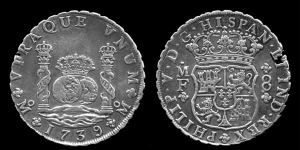
Important Dates in the Monetary History of the United States, Part IV, 1792 – Coinage Act of 1792
By David Liechty
The Coinage Act of 1792 (Act of 2 April 1792, , ch. 16, 1 Stat. 246 , ) further codified English Common Law principles regarding monetary policy as described by Blackstone. In this Act, Congress established a standard of value, a monetary “unit”, against which the value of all other commodities, services, etc., in the market would be compared. The “Unit” of value adopted, termed the “dollar” (§20, 1 Stat. at 250), was a coin “contain[ing] three hundred seventy one … and four sixteenths [(371.25) grains] of pure … silver”, and was set equal in value to “the Spanish milled dollar as [then] current,” or in use, in the Colonies (§ 9, 1 Stat. at 248). Half- dollar, quarter-dollar, “dismes” (or “tenths”), and “half-dismes” were also established, each containing a proportionate amount of silver, and Congress also created copper “cents” and “half- cents” (id).
Congress further established gold coins, “Eagles” and “Half-Eagles”, which were to “be of the value of ten [and five] dollars or units” respectively (id.). Statutorily setting a silver to gold exchange rate of 15:1 (§11, 1 Stat. at 249), close to its historical average, Congress required gold “Eagles” to contain the equivalent amount of gold, i.e., 247.5 grains, to make them equal in value to the silver contained in ten “dollars or units,” i.e., 3,712.5 grains of silver. The amount of gold required for Half-Eagles was also set in this way (§9, 1 Stat. at 248). Gold coins were not termed “dollars,” but were to “be of the value”, or equivalent to, a certain number of “dollars or units” of money as established (id). Congress in this way set silver coin of a specified weight and fineness as the benchmark “unit” of value for the United States, following the English
Common Law tradition. Gold, like any other commodity, was to be valued in relation to this standard “unit”. Congress, empowered by the Constitution to “regulate the Value” of its coinage (Article 1, §8, cl. 5), set the rate of exchange between gold and silver for these purposes, and created gold coins according to this rate and the amount of silver in the benchmark “unit.” Essentially, Congress put the United States monetary system onto a “silver standard .”
Coins “struck at, and issued from” the mint established in this Act Congress made “lawful tender in all payments whatsoever,” those of “full weight” according to their statutory value and those “of less than full weight” at “values proportional to their respective weights” (§16, 1 Stat. 250). In this way, Congress reaffirmed the role of the statutory “dollar,” the “full weight” of silver, as the nation’s standard of value, the measurement against which all other commodities or services, etc. would be compared and valued.
By the Act of 1792, Congress also provided for free coinage, wherein private parties could bring gold or silver bullion to the mint to be coined (§14, 1 Stat. at 249). For a “one half per cent” fee, the individuals could receive previously-minted coin immediately, or, for no fee, they would receive “coins of the same species of bullion …, weight for weight” when their bullion was actually coined (id). Those government employees responsible for the coining process were required to post “sureties” of $10,000 each (§5, 1 Stat. at 247), were given annual salaries of $1,500 (§6, 1 Stat. at 247), could be fined $1,000 for giving “preference” in the coining process (§15, 1 Stat. at 250), and were subject to capital punishment if found debasing the coin (§19, 1 Stat. 250).
David Liechty is an attorney who is currently studying for a Phd in Constitution Studies. He is interning with Solari this summer.

